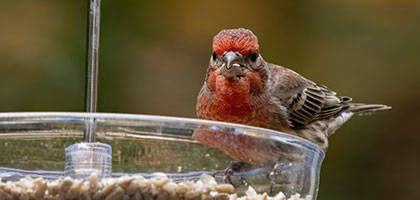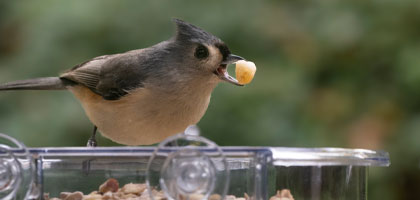Winter can be a challenging time for cardinals. These vibrant birds are non-migratory, meaning they stay in their range year-round.
When food sources become scarce, survival becomes a struggle. That's where bird enthusiasts like you come in. By providing a reliable food source, you can help these beautiful creatures thrive during the colder months.
This guide will provide practical tips on feeding cardinals in winter. We'll explore the types of food, feeders, and practices best suited for attracting and sustaining these birds.
From sunflower seeds to suet cakes, and large bird feeders to window feeders, we'll cover it all. We'll also delve into how to create a cardinal-friendly habitat and keep these birds coming back.
Whether you're a seasoned bird watcher or a beginner, this guide will equip you with the knowledge to support cardinals in winter. Let's dive in and discover the joy of winter bird feeding.
Understanding Cardinals' Winter Needs
Cardinals are resilient birds that endure cold winters by staying in their home range. They don't migrate, making them dependent on available food during the icy months. Finding adequate food is crucial because their energy needs spike as temperatures drop.
Food scarcity isn't the only challenge cardinals face in winter. Shelter from the harsh elements and protection from predators are equally important. A balanced environment, providing both food and safety, increases their chances of survival. By understanding these needs, you can create a sanctuary for cardinals during the wintry season, ensuring they remain healthy and energetic.
The Best Foods to Offer Cardinals in Winter
Providing the right food is key to attracting and keeping cardinals during winter. Sunflower seeds are a top choice, thanks to their high fat content. These seeds provide essential energy, and their shells offer protection against the weather.
Safflower seeds are another popular option among cardinals. They contain a rich mix of proteins and fats. Moreover, safflower seeds are less attractive to squirrels, reducing competition at the bird feeder.
Peanuts and other nuts also appeal to cardinals. Offering them unsalted and shelled ensures the birds get maximum nutrition. Nuts are an excellent source of energy and are easy for cardinals to consume.
Fresh fruit provides cardinals with natural sugars and liquids. Apple slices or berries can be placed near feeders to entice these vibrant red birds. Fresh fruit is a great supplement, offering vitamins and variety to their diet.
In addition to seeds and fresh food, suet products are ideal during colder months. Suet pellets, cakes, and balls offer high-energy fats that help cardinals keep warm. Including these foods in your bird feeding routine will ensure cardinals have access to vital nutrients all winter long.
Choosing the Right Feeders for Cardinals
Selecting the right bird feeder is crucial for attracting cardinals. These birds prefer feeders with ample space to perch and feel secure. Large bird feeders are ideal as they can accommodate multiple cardinals at once.
Types of Feeders for Cardinals:
- Large bird feeder
- Suet feeder
- Peanut feeder
- Seed feeder
A suet feeder is essential for offering high-energy suet products. These feeders are designed to hold suet cakes or balls securely. They draw cardinals and other bird species, providing them with a rich source of fat.
Peanut feeders are perfect for dispensing nuts, a favorite snack for cardinals. They feature mesh or wire designs that allow easy access to peanuts. By including a peanut feeder, you ensure cardinals have a nutritious treat during winter.
Seed feeders are versatile, able to hold various seeds and mixes. These feeders are great for offering the sunflower and safflower seeds preferred by cardinals. Choose a sturdy seed feeder to prevent spills and keep the food dry.
Feeder Placement and Safety
Where you place your feeders can significantly impact their effectiveness. Cardinals prefer feeders that are positioned at a safe distance from the ground. This helps protect them from predators like cats and ensures they feel secure while feeding.
It's vital to place feeders near natural shelters. Surrounding them with trees or shrubs can provide a sense of safety for cardinals. These natural covers offer protection from harsh weather and potential threats.
Additionally, consider feeder safety with regards to your home. Position feeders away from windows to prevent collisions. Using reflective decals on windows can make them visible to birds, reducing the risk of injury.
Protecting Your Feeders from Squirrels and Other Pests
Squirrels and raccoons can quickly deplete bird food meant for cardinals. To keep these pests away, consider using a squirrel proof feeder. These feeders are designed to limit access, allowing only birds to feed.
Placement matters when deterring unwanted guests. Hang feeders on a pole with a baffle to prevent climbing. Additionally, keeping feeders at least five feet off the ground can make it more challenging for pests to reach them.
For added protection, choose feeders with tightly fitting lids. This can prevent larger animals from accessing the bird seed. Regularly checking your feeders for signs of tampering will also help maintain the integrity of your feeding setup.
Creating a Cardinal-Friendly Habitat
Creating a welcoming habitat is crucial for keeping cardinals nearby. Cardinals appreciate dense trees and shrubs for shelter. Planting native vegetation can provide them with safe spaces to rest and hide from predators.
Consider installing birdbaths, as water is vital, especially during winter when natural sources may freeze. Regularly breaking ice or placing a water heater can ensure water is available. Cardinals also enjoy bathing, making birdbaths a dual-purpose feature.
Adding elements like natural shelter not only attracts cardinals but supports a diverse ecosystem. Avoid using pesticides, which can harm wildlife. Encouraging a pest-free garden helps maintain a safe environment for cardinals to thrive.
Consistency and Timing: When to Feed Cardinals
Consistency in feeding can significantly impact whether cardinals keep returning. Regularly replenishing food offers the reliability that these birds seek. A predictable routine can make your feeders a favored dining spot.
Cardinals are typically early risers. They often visit feeders at dawn, setting the tone for your feeding schedule. Offering fresh food during early morning hours can help ensure they are attracted to your yard.
Feeding cardinals also extends beyond mornings. Cardinals might return during late afternoon, especially before nightfall. Keeping feeders stocked throughout the day can increase their visits and help maintain their energy.
Additional Tips for Attracting Cardinals
Attracting cardinals involves more than just providing food. Offering water sources, such as heated birdbaths, is also essential. Fresh water helps cardinals stay hydrated during the cold months.
Beyond food and water, cardinals need safe places to nest. You can support their nesting by providing materials like twigs and dry grasses. These offerings may encourage cardinals to linger in your garden.
A clean feeding area is crucial for bird health. Regularly clean your feeders to prevent disease and mold. Keeping the area tidy will enhance the attractiveness and safety of your bird-friendly habitat.
Conclusion: The Joy of Winter Birdwatching
Watching cardinals in your winter garden can be a heartwarming experience. Their vibrant feathers stand out against the snow, bringing color to the bleak winter landscape. Cardinals offer a unique opportunity for birdwatchers to enjoy nature's beauty throughout the colder months.
Feeding cardinals in winter ensures they return to your yard time and again. Providing the right food and environment creates a reliable refuge for these magnificent birds. In return, you'll be rewarded with their presence and delightful songs.
Embracing winter bird feeding can foster an appreciation for wildlife conservation. By creating a cardinal-friendly habitat, you contribute to the thriving diversity of local ecosystems. Each visit from a cardinal is a reminder of the wonders of nature.




